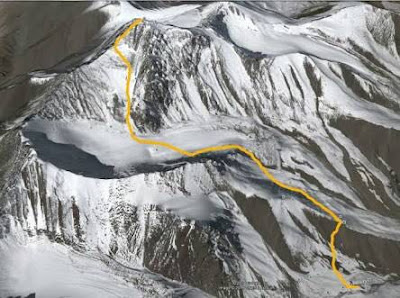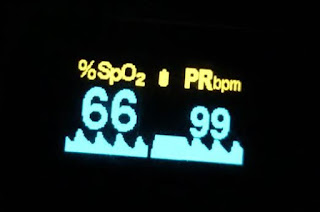My first visit to the Himalayas as an 18yr old 2nd
yr Medical student, for the Basic Mountaineering Course in Manali WHMI, was enough
to be smitten by the bug…. To scale a Himalayan peak some day. 24 yrs later, having
climbed many ‘peaks’ in personal and professional life were still not enough to make
this bug go away. Despite 5 odd occasions of roughing out in the Himalayas over
the years, 3 training courses and time spent in high altitude and in tents on
glaciers & frozen rivers, scaling the “summit” always stayed elusive.
 |
| A well set Surgeon and Anaesthetist can go a long way together! |
My perennial "partner in crime" for these ventures – Dr. Prasanna
Mahajan, Anaesthetist @ Mumbai – and 7 others set out in end July to climb a
20,000 er in the Himalayas. 20,000 ft is a psychological barrier in the
Himalayan heights, given that even Mount Everest is at 29029ft , effectively there
is no point on the planet that crosses over into the 30,000 - the height at which commercial airlines fly!
 |
| That's where I dream to be! |
 |
| View of Summit route seen from Google Earth |
The intrigue of high altitude climbing lies in adjusting to
the rarefied atmosphere with scarce Oxygen, which chokes and suffocates the body internally. If your body gets over this stress, you survive and enjoy; if the stress gets the better of you – it results
in Acute Mountain Sickness (AMS), with headache, vomiting initially, and rarely
severe breathlessness and drowsiness in severe cases due to fluid accumulating
in the lungs (HAPO) OR brain (HACO). Unless the person is given Oxygen
supplement (from a cylinder) OR rapidly shifted to a lower altitude, the
condition is often fatal.
It is a common adage among Mountaineers, the slower you go,
the longer you last – meaning: Gain altitude slowly, let the body adjust and
then perform well.
 |
| Being "air dropped" into 11,200 coming from Sea Level: At LEH Airport |
We left into the mountains on day 3 from Stok village at 11,200 ft, the last habitation before we were cut off from civilization. After a overnight halt we reached Chang Ma camp at 14,700ft, where we got our first view of the summit since we left Stok began the trek.
We stayed put here for a day, as a safety to acclimatize better having gained 3,000 feet height since we began.
We finally .reached base camp at 16,400 feet on Day 6. By then, everyone in the team had at least 1-2 episodes of either headache OR vomiting since we began, I had three!
We finally .reached base camp at 16,400 feet on Day 6. By then, everyone in the team had at least 1-2 episodes of either headache OR vomiting since we began, I had three!
The summit attempt was scheduled to begin at 10PM on the night of Day
7, August 4th. The Himalayan heights are best negotiated before
10AM, or 11AM at the most. With each passing minute after that, the heat of the
sun melts the ice, softens the snow and makes movement increasingly difficult,
besides other hazards. So, at any cost we had to finish summit by 10AM next morning, and
begin the return journey. A 12odd hour walk in the rarefied atmosphere awaited us
now.
As yet another effort to acclimitize, we went on a short 3 hour acclimatization walk that morning, to an adjacent hill to reach upto 17,600 ft.
To our pleasant surprise, our mobile phones connected to the network en route, and we connected to folks back home for the first time in 4 days after we left Leh city. We had now significantly risen above the hills that stood between us and the mobile towers in the city!
 |
| View of Base camp tents [yellow - blue dots] at 16,500 - taken from 17,500 ft. The trail seen behind, taking off almost vertically, is the road to the heaven.. [summit I mean :) ]. |
To our pleasant surprise, our mobile phones connected to the network en route, and we connected to folks back home for the first time in 4 days after we left Leh city. We had now significantly risen above the hills that stood between us and the mobile towers in the city!
 On return to base camp, the rest of the day was spent on a forced rest within our tents, in anticipation for the long day (rather
night) ahead. We had to plan for an effort that could last upto 16 - 18 hours
of high altitude walking.
On return to base camp, the rest of the day was spent on a forced rest within our tents, in anticipation for the long day (rather
night) ahead. We had to plan for an effort that could last upto 16 - 18 hours
of high altitude walking.
The pic on the right is the Blood Oxygen saturation of a well acclimitized body at 16,500 ft: thanks to the Pulse Oximeter I carried. For Doctors like me, a reading of SpO2 < 90% for anyone in a hospital will send a shiver down the spine - meaning the patient is seriously ill. And here we were happily smiling and jumping around, with the pulse rate at a healthy 99bpm, while the SpO2 was way below!
We finally set off for the summit at 10:30PM that night, loaded with high energy foodstuff, 1.5 L water each, 5 layers of clothes on top, a headlight to show us the way, and lots of excitement and hope for a good weather and a favourable outcome. One of our 9 member team chose not to begin, at he was not up to it. We steadily climbed 2 odd hours and reached the Stok glacier at 17500ft in good time. Unfortunately by this time, four more of our members decided to opt out of the journey. The rest of us then attached spikes to our hiking shoes, to help us grip the hard surface, and crossed the ice covered glacier smoothly.
We finally set off for the summit at 10:30PM that night, loaded with high energy foodstuff, 1.5 L water each, 5 layers of clothes on top, a headlight to show us the way, and lots of excitement and hope for a good weather and a favourable outcome. One of our 9 member team chose not to begin, at he was not up to it. We steadily climbed 2 odd hours and reached the Stok glacier at 17500ft in good time. Unfortunately by this time, four more of our members decided to opt out of the journey. The rest of us then attached spikes to our hiking shoes, to help us grip the hard surface, and crossed the ice covered glacier smoothly.
While on level ground a healthy person can easily walk a few
steps with a single breath cycle (one inhalation + one exhalation), in the
mountains (or when running OR any stress elsewhere) it drops to two steps per
breath, and finally to one step per breath. If you can settle down into a rhythm
at this time, you will be fine: this is how we walked the entire night, and
especially on this next stretch. If you need more than one breath to take a step,
things are not going well for you.
 |
| Pre dawn climb with headlamps on the long 2000 ft slope |
I counted and walked 50 steps before I took a break of a
minute, before the same sequence was repeated. This was repeated again and again and again and... As reinforced by my climbing Mentors, it was purely a mind game hereon. If you are fit, the
body will obey what the mind commands. If the mind wavers, the feet will not move even if you are fit!!! My wait of 20 odd years was more than an adequate motivator, to fuel each step
towards the coveted summit.
 |
| Calamity @ 19,800 ft: seated guide trying to fix my spikes, while I pray desperately. |
The remaining 3 of us were going well, until I ran into a freak problem at around 5AM at 19,500 ft – my spikes were slipping off my snow shoes.For every 1 step on the 60 degree snow slope I took, I was sliding 2
steps down as my feet failed to grip the surface. After 3 attempts to
rectify the same – by two different people, I gave up. There was a long way
back to the camp, and a steep long slope to descend, and taking unjustified
risks when we were already stretched on resources was not a good idea. And all
this despite being 400 odd feet short of the summit! With this, my dreams of
the summit came crashing down, and all hopes kept alive since years ago ….but as a
slicker for safety and a ruthless Surgical training to guide me, I took the hard decision knowing life will always give another chance, provided I am safe and sound… and with a heavy heart slowly
began my way back with one of the 2 guides.
Unfortunately for the team too, just 100 odd feet ahead, one of
the remaining two ran out of juice, and he could not continue further, even
though just the final 300 feet remained...
 |
| Summit of Stok Kangri take from 20,000 feet - Shoulder point. |
Now they were in an even greater dilemma – with only
one guide remaining: he could not go to the summit, leaving the other person to
wait. At these heights close to 20,000, you can’t stay put and wait anywhere;
you either have to keep walking OR you will freeze to ice in a short while. And
neither could anyone be asked to make the 5 hour journey back alone.
 |
| Valley & Ridges below Stok summit, with Dawn having set in, taken from 20,000ft |
The team then took the right but difficult decision to
abandon the climb, barely 300 feet and in visible distance off the summit. Thus
despite having ample time, and the body having adjusted well, with the best of
weather conditions, we still could not make it even after being within striking
distance. That’s how unpredictable the mountains are! In fact we returned to base camp
back by 10AM, after an uneventful return.
Having rested our fallen spirits the entire day, next morning we set out on the return walk back to Leh city,
lost in thought – What else can we do to scale a Himalayan Summit? I realized how
true it was when the summiters said “I could climb because the mountains let me – the Himalayas only let you come as close as they want, only as long as they
want!!!"
On the return journey, all the picturesque scenes that escaped our notice on the way up, were now savored to the fullest.
 |
| View towards Chang Ma camp, seen from Base camp |
 |
| Enchanting stream for some mountain fresh pristine water!!! |
 |
| En Route from Chang Ma camp to Stok Village. |
 |
| Leh city ahead, and Khardungla Pass and road to Nubra valey, Siachen glacier in the background. |
We covered downhill in a single day, what took us four to climb! As expected, plans to come back another time, were already made on the return.However, as a medical professional, this perhaps meant a wait of 2-3 years or so.
We returned back contented, despite a tinge of
disappointment, to our eager families and friends back home.
With this invigorating break, we finally got back to our routine, with greater energy and
enthusiasm
for quite some days to come! 



